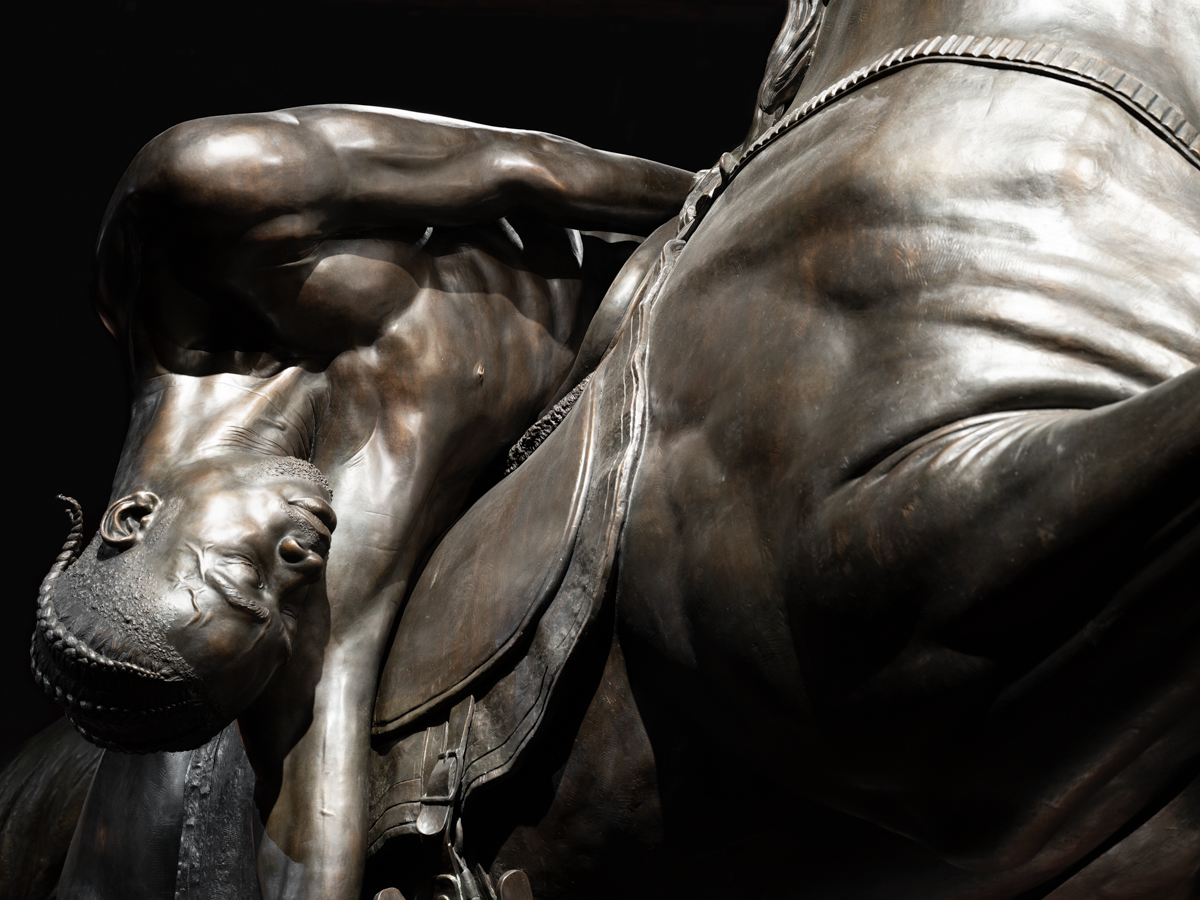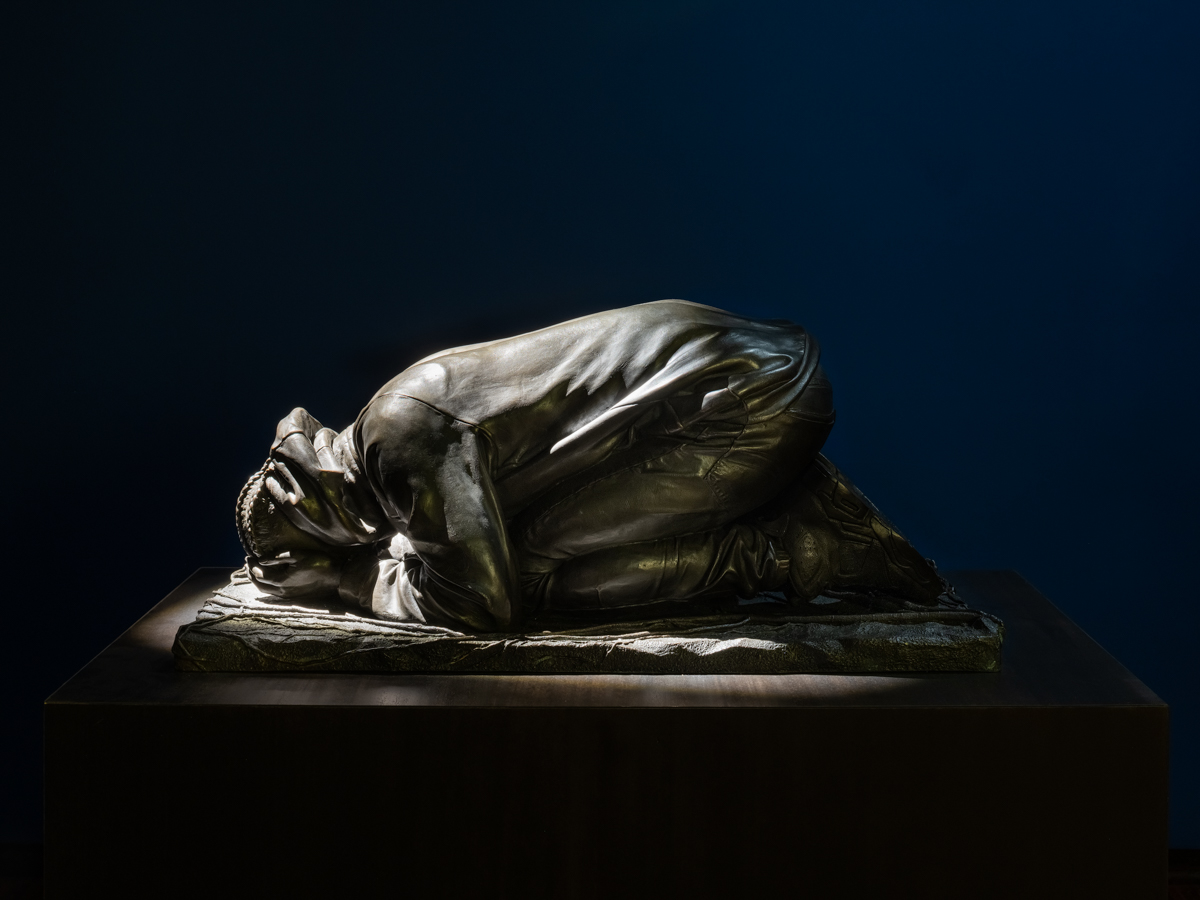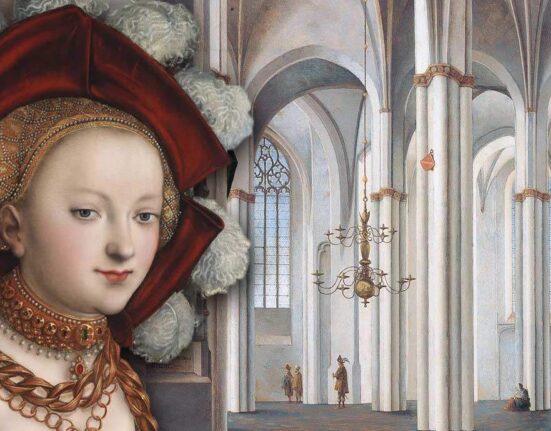
©️ Kehinde Wiley. Courtesy the artist and Templon, Paris, Brussels, and New York.
A towering 13-foot bronze equestrian statue gets its own dedicated room in Kehinde Wiley’s exhibition at the de Young Museum. Modeled after a monument portraying Confederate general J.E.B. Stuart, An Archaeology of Silence (2021) depicts a shirtless Black man draped over the saddle of a horse. Here, Wiley unflinchingly portrays the ugly reality of Black soldiers who fought for freedom in the Civil War, only for the survivors to return to a hostile terrain of continued anti-Black violence.
This somber work is a welcome outlier in Wiley’s oeuvre. His current exhibition, which debuted in Venice in 2022 before traveling to Paris and the United States, takes its title from this monumental equestrian. Wiley is better known for idealistic paintings of Black people dressed in designer streetwear and presented in heroic poses typically reserved for their white counterparts in European art history. His 2019 equestrian sculpture, Rumors of War, places a Black rider boldly gazing down Richmond’s Monument Avenue which, until recently, was lined with statues of Confederate generals. Often, his paintings quote directly from the Western canon; horses, borrowed from an iconography of glory that dates back to the Roman Empire, are a frequent motif.

Kehinde Wiley, An Archeology of Silence (detail), 2021.
Wiley demands Black representation in the canon and the museum by adhering to the strict artistic formulas that these exclusionary institutions champion. His monumental paintings use naturalism, painterly skill, and intricate details—from curling foliage to designer logos—to fashion his subjects within the long tradition of European court paintings.
Surely, these skills helped him secure the presidential portrait commission in 2018 from Barack Obama. In a sense, Wiley trained to paint this portrait of power his entire career; tellingly, his non-presidential paintings look similar to that commission. The former president, like Wiley’s work, has come to exemplify how merely placing a Black person in a position of power is not enough to change the racist status quo. (In addition to his historic victory as the first Black US president, Obama’s legacy also involves brutal deportation policies and a ready embrace of drone strikes.)
Wiley’s new paintings and sculptures, made between 2021 and 2022, only render the disturbing dynamics of his older pieces more pronounced. “An Archaeology of Silence” makes abundantly clear that reckonings with history cannot be as simplistic as supplanting Black protagonists into narratives and compositions built on imperialism and anti-Blackness.
This latest body of work reinterprets scenes of martyrdom, war, and slumber from the European art historical canon. In this, they more or less rehash his “Down” series (2007–09): glowing paintings of Black figures in various states of repose set against jewel-toned florals and foliage. He attributes his return to this subject matter to the summer 2020 global uprisings sparked by George Floyd’s murder at the hands of Minneapolis police.
When “Down” debuted 15 years ago to an art world even less diverse than the present one, Wiley’s focus on dignified representation long absent from popular visual culture felt urgent. Now his depictions of fallen soldiers, saints, and even Greek gods are set explicitly against the backdrop of systemic violence that has long eluded Wiley’s inquiry.

Kehinde Wiley: Reclining Nude in Wooded Setting (Edidiong Ikobah), 2022.
In Christian Martyr Tarcisius (El Hadji Malick Gueye) (2021), Wiley replaces the young boy from Alexandre Falguière’s 1868 marble sculpture with a man he knows. The original work depicts the moment Tarcisius refused to surrender the sacraments he was carrying; for this refusal, he was stoned to death. Here and elsewhere, Wiley borrows compositions concerning sacrifice and martyrdom. But unlike Tarcisius, Saint Cecilia, and Christ—all of whom are referenced in the show—Floyd, whose death inspired the series, was not a martyr who chose to die for a cause. The implication recalls that of Congresswoman Nancy Pelosi, when she thanked Floyd for “sacrificing [his] life for justice.”
Throughout the show, Wiley spares viewers the explicit, bloody gore of death so often circulated online. He depicts his subjects with unwounded skin, echoing the Roman Catholic and Eastern Orthodox belief that the bodies of saints are incorruptible and exempt from the rules of nature reserved for ordinary human bodies. The bronze Dying Gaul, after a Roman Sculpture of the 1st Century (2021) features a Black man in a hoodie in a semi-recumbent pose, supporting himself on one arm as vines wrap around his extended leg. Although it references an ancient Roman sculpture of a gladiator bearing a mortal wound to the chest, replete with intricate blood droplets carved in marble, Wiley’s Dying Gaul has no visible signs of injury.
Several of Wiley’s works quote European precedents but keep his subjects largely unharmed. The clothed figure in his painting Reclining Nude in Wooded Setting (Edidiong Ikobah),2022, lies on a grassy ground with her hips twisted to face the viewer, much like the woman in Victor Karlovich Shtemberg’s work of a similar title. It’s unclear whether she is slain, like many figures in the show, or in repose. This seems like an important distinction. And either way, Wiley’s subject manages to keep her bright white shirt unstained and shoes unscuffed as she lies in dirt.

Kehinde Wiley: Young Tarentine I (Babacar Mané), 2022.
Most of the show seems to gloss over loss, but this is punctuated by Wiley’s Youth Mourning (El Hadji Malick Gueye), After George Clausen, 1916, (2021), a sculpture of a child hunched over on the ground, head in hands. This work, in capturing the feeling of all-consuming, earth-shattering grief, succeeds where much of the exhibition fails. It is decidedly empathetic, and does not endeavor to make metaphor out of tragedy.
In the audio guide, Wiley says, “There’s so many opportunities now to talk about lost potential as a means to create a scaffolding for a better future.” By using the visual language of European colonial power and religious iconography without scrutiny, Wiley’s vision of the future is a constrained one. He may play with systems of power, but he does not shatter them.






